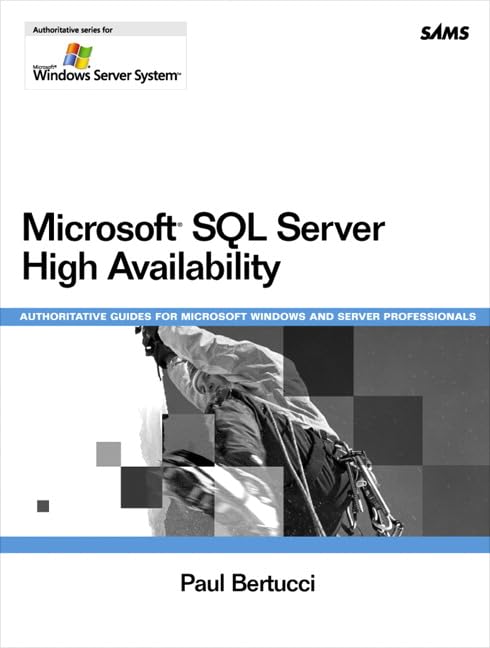

Most ebook files are in PDF format, so you can easily read them using various software such as Foxit Reader or directly on the Google Chrome browser.
Some ebook files are released by publishers in other formats such as .awz, .mobi, .epub, .fb2, etc. You may need to install specific software to read these formats on mobile/PC, such as Calibre.
Please read the tutorial at this link: https://ebookbell.com/faq
We offer FREE conversion to the popular formats you request; however, this may take some time. Therefore, right after payment, please email us, and we will try to provide the service as quickly as possible.
For some exceptional file formats or broken links (if any), please refrain from opening any disputes. Instead, email us first, and we will try to assist within a maximum of 6 hours.
EbookBell Team

5.0
48 reviews 
ISBN 10: 0672326256
ISBN 13: 978-0672326257
Author: Paul Bertucci
Offers example based coverage for various high availability solutions with Microsoft SQL Server.
Chapter 1 – Introduction to Business Intelligence
What Is Business Intelligence?
Transaction Systems and the Search for Information
Why OLTP Reporting and Analysis Fails to Deliver
The Data Warehouse Design
Time and the Data Warehouse
Getting Data into the Data Warehouse
OLAP to the Rescue
Getting Information out of OLAP Databases
Why Is OLAP So Fast?
Dimensional Modeling Concepts
Hierarchies
Stars and Snowflakes
Choosing Between Star and Snowflake for a Dimension
Using Surrogate Keys
Designing a Dimensional Data Model
Business Value-Based Approach to BI Projects
Business Intelligence Project Pitfalls
Summary
Chapter 2 – Development and Management Tools
SQL Server Database Engine
Management
Security
Availability
Integration Services
Designing Packages
Deploying and Configuring Packages
Analysis Services Architecture
Development Environment
Managing and Securing Analysis Services
The Unified Dimensional Model
Support for Large and Mission-Critical BI Solutions
Reporting Architecture
Reporting Services Features
Managing and Securing Reports
Data Mining
Data Mining Architecture
Data Mining Features
Full-Text Search
Summary
Chapter 3 – Defining the BI Problem and Requirements
Problem Statement
Business Requirements
Business Benefits
Process Focus
Level of Detail Needed
Ways of Looking at the Information
Measuring Metrics
Technical Solution
Building Dimension Tables
Building Fact Tables
Securing the Data Warehouse
Deployment, Maintenance, Operations
Using the BI Development Studio
Summary
Chapter 4 – Building a Data Integration Process
Solution Overview
High-Level Architecture
Business Benefits
Data Sources and Destinations
Loading the Dimensions
Loading the Fact Table
Loading Budget Information from Excel
Loading Multiple Sets of Data
Deployment, Maintenance, Operations
Data Quality and Other Transformations
Summary
Chapter 5 – Analysis Services: Cubes and Dimensions
Problem Statement and Requirements
Handling On-Time Shipments
Building the Initial Cube
Setting Up and Modifying Dimensions
Deployment, Maintenance, Operations
Using BI Development Studio in Online Mode
Summary
Chapter 6 – Reporting Services
Problem Statement and Requirements
Data Model
Accessing Reports
Presenting and Securing Information
Subscribing to Reports
Managing the Solution
Deployment, Maintenance, Operations
Using Report Builder for End-User Reporting
Summary
Chapter 7 – Data Cleansing and Integration
Business Problem and Solution Overview
Merging and De-duplicating Customer Data
Dealing with Missing Dimension Members
Adding Row Counts for Auditing
Preventing Bad Data at the Source
Operations, Next Steps
Summary
Chapter 8 – Managing Dimensions and Historical Data
Problem Statement and Requirements
Managing Dimensions Without Preserving History
Managing Dimensions to Preserve History
Updating Dimensions with Changing Attributes
Detecting Changes in Source Dimension Data
Inserting Facts with Surrogate Key Lookups
Analysis Services Dimension Changes
Managing the Solution
Operations
Dealing with Updated Facts
Summary
Chapter 9 – Business Metrics and Scorecards
Problem Statement and Requirements
Handling Calls, Crime Reduction, and Professional Standards
Public Feedback
Analysis Services Database
Building Reports and Scorecard Portal
Deployment, Security, Maintenance, Next Steps
Supporting Multiple Languages
Summary
Chapter 10 – Web Analytics and Data Mining
Problem Statement and Requirements
Tracking Website Visitors and Attributes
Adding Visit Information to the Data Warehouse
Using Data Mining for Customer Segmentation
Creating Models for Product Recommendations
Integrating Data Mining into Web Applications
Deployment, Operations, Other Possibilities
Summary
Chapter 11 – Large Data Volumes and Partitioning
Problem Statement and Requirements
High-Level Architecture
Partitioned Tables and Large Data Loads
Partitioning Analysis Services Cubes
Aggregation Design
Large Dimension Support in SQL Server 2005
Managing Table and Cube Partitions
Automating Processes and Scaling Out
Summary
Chapter 12 – Real-Time BI Solutions
Problem Statement and Requirements
Cube Design for Real-Time
Real-Time ETL and Operations
Loading Data Directly into Analysis Services Using Integration Services
microsoft sql server high availability architecture
microsoft sql server high availability best practices
microsoft sql server high availability options
microsoft sql server high availability licensing
microsoft sql server 2022 high availability
Tags: Paul Bertucci, Microsoft SQL Server, High Availability